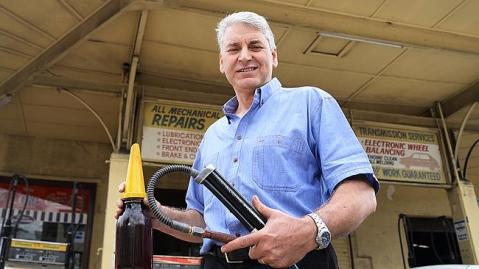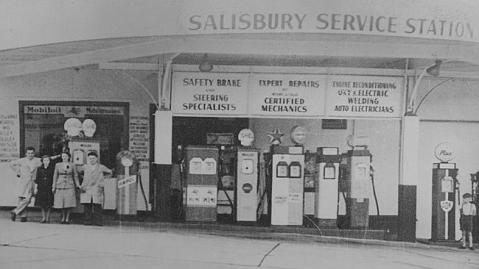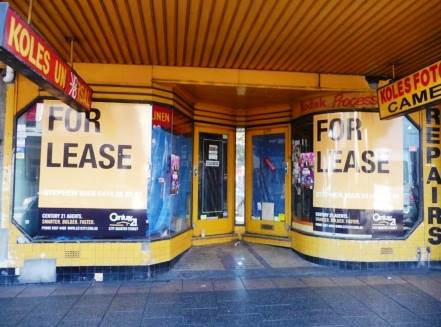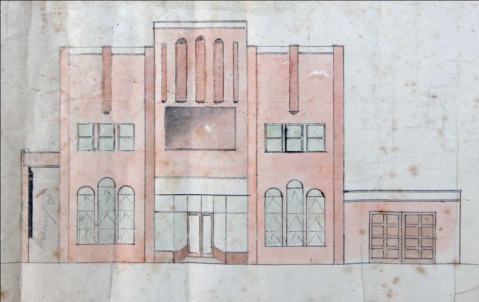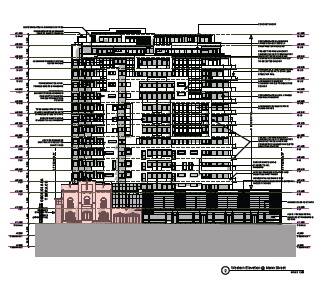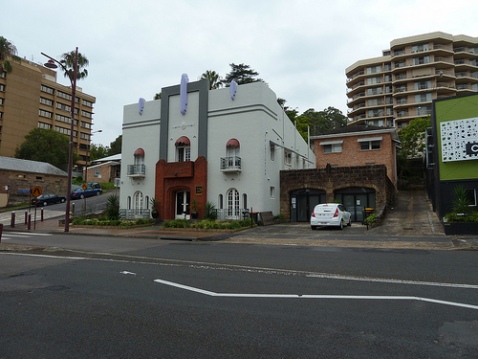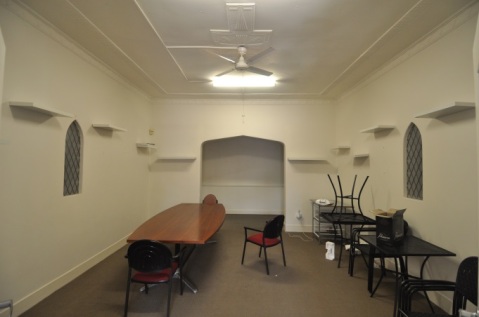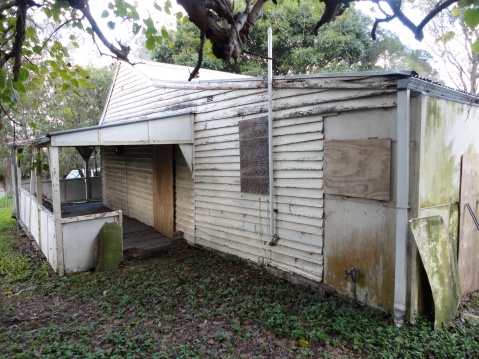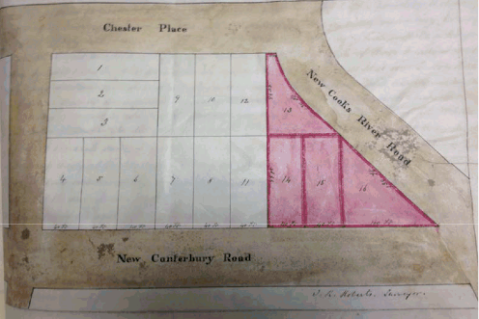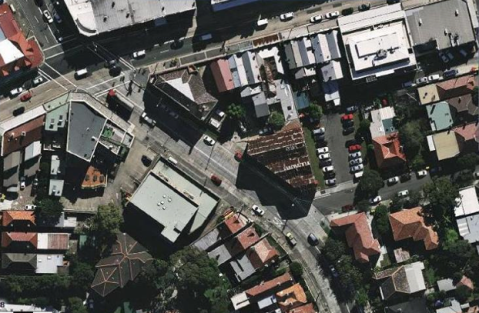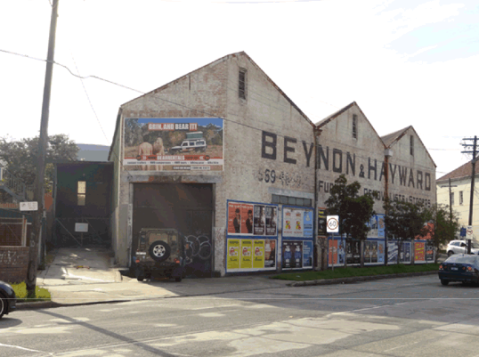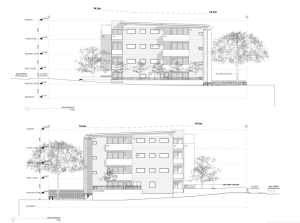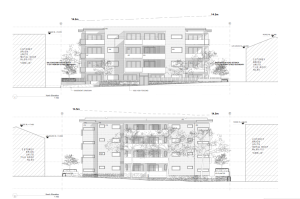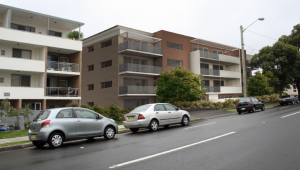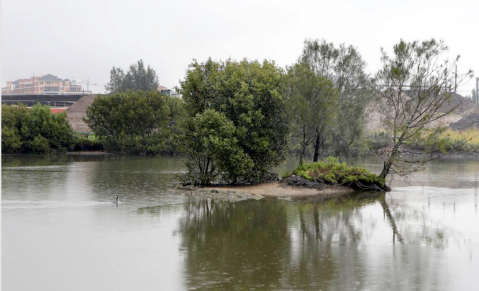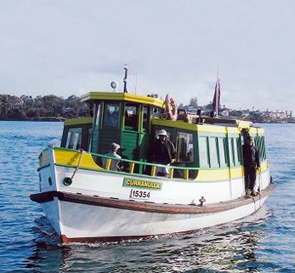LIFE AND DEATH OF THE FULL SERVICE STATION

If you are a lover of Art Deco as am I, you may be slightly miffed by the loss of one of Sydney’s only remaining original 1930s full service stations. If you have been swayed by the Petrolmania craze that has taken over our televisions you may be a little saddened by the closure of one of the last purveyors of oil from glass bottles and classic automobile nostalgia. And if you are simply a fan of good old-fashioned driveway service you may just miss the welcoming sight of the Salisbury Service Station at Stanmore for it is about to be wiped from our motoring maps and minds forever.
You certainly won’t miss the rising concrete frame of yet another block of boutique apartments with an overzealous moniker, this time known as ‘The Radius’, perhaps as some kind of bizarre lip service homage to the semi-circular floorplan of the Art Deco structure it is destroying.
The family-run business is set to shut up shop and leave the Percival Road location it has graced since 1930, having being sold to a developer who will make full use of the prime inner west location and valuable crossroads pocket of land.
Current owner Norm Iacono doesn’t seem to be all too upset with the outcome. He took over the reigns from his grandfather in 1997, ran the shop for several years and is now happy to be moving the business to Summer Hill while selling the Stanmore site for a king’s ransom. Pointing the blame at higher running costs due to petrol storage laws, his comments to media that “A lot of people come in and say what a great building it is, but the building was built in the 1930s, so there is no real significance for architecture” initially struck me as slightly odd for a small business owner who has traded not only in petrol but also nostalgia for so many years. After all, you don’t see too many Art Deco service stations from the golden era in such original unchanged working order. But when you consider he is set to benefit financially by the full demolition of the site you can see how quickly nostalgia is pushed to the side like some old rattle gun that has come to the end of its useful life.
Norm is hopeful however that the developer will pay some sort of tribute to the heritage of the site, by displaying the oil bar near the entrance to the restaurant or something to that effect… It could have a Model T Ford parked in the foyer for all I care, it will still be just another oversized concrete box with a Model T parked in its foyer. There is simply no substitute for the original item.
It would have been nice to retain at least the drive-through frontage part of the structure and re-purpose that as an outdoor cafe – I mean, we are talking a matter of a few square metres for pity’s sake, would it be so hard to retain at least that much heritage within the total area of the site?
Unfortunately this buy-up of prime service station sites across Sydney is not confined to just this fine example. It is happening all over and many old independent stations are being bought and converted into apartments as developers fight to get hold of these prime main arterial slices of land. Among others, another Art Deco workshop at Princes Highway Tempe recently closed and is slated for residential redevelopment.
And sadly the lack of understanding and protection of Art Deco is not limited merely to the destruction of petrol stations. Retail shopfronts of the era are also making way for the modern. This one in particular at Liverpool Rd. Ashfield, a beautiful example of 1930s expression, is set to go. A DA for the total removal of the Koles Foto/Manchester shopfront was approved in August by Ashfield Council who don’t seem to appreciate the beauty of their own area enough to respect its architectural merits. What will rise in its place will undoubtedly not share the same level of pizazz this shopfront exudes. Sad times indeed for fanciers of Art Deco and Sydney heritage moreover…
Main title image Daily Telegraph.
URGENT: GOSFORD FUNERAL PARLOUR FACES ITS OWN MORTALITY
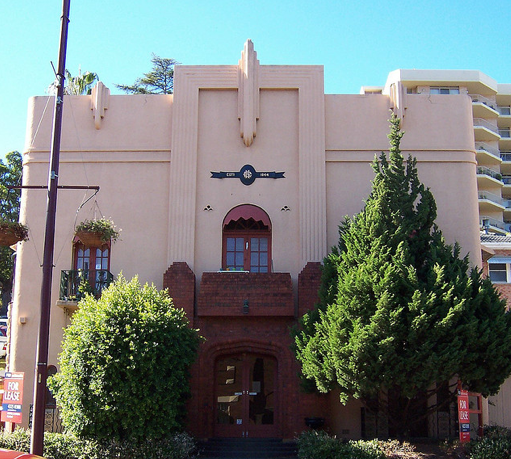
A stunning heritage-listed funeral parlour near the waterfront in Gosford that has ushered out the lives of many local identities is itself facing the possibility of an untimely end. Creighton’s Funeral Parlour at 37 Mann Street was built in 1938 in the Art Deco style by architect F. Vanderwyck Snr. The Creighton’s family business was known in the area since 1844 and was involved in building and demolition work before becoming funeral directors in 1872. Six generations of the Creighton family practiced locally under the business name.
The building is treasured not only because of its association with the well renowned family, but because it is such a marvelous and rare example of an Art Deco purpose-built funeral parlour.
Externally, a grand central arch surrounded by decorative red brickwork heralds the main entrance. This is flanked on either side by secondary arches with quality timber framed lead glazed windows, and the theme is continued on the upper floor with a trio of balconettes showing ornate cast iron balustrades, and three magnificent streamlined parapets at roof level surging into the sky. Decorative balustrades also surround the lower windows. The construction is of textured cement rendered brick, comprising two stories at Mann Street, sloping back steeply to become one storey at the rear.
On the Georgiana Terrace side (left hand, facing) is an enclosed balcony made of locally quarried rock-faced ashlar sandstone while on the opposite wing is a sandstone garage consisting of twin Tudor arches and matching parapet. Behind the garage doors are open concrete pits to allow access for working on the funeral hearses. This has been currently re-purposed as a cocktail bar, showing clever use of a heritage asset. Rather interestingly, the roofline on the Georgiana Terrace side is scalloped while the garage side is straight-lined.
Internally, a central porch leads to the house chapel that extends below street level and is surrounded by small offices. An interesting feature are the backlit frosted glass windows obviously created due to a lack of natural light filtering into the room. Original drawings for the floorplans show that very little has been changed since 1938.
The parlour is located right in the middle of an identified heritage precinct containing several unique buildings, some of which the Creighton family were involved in constructing, including the heritage-listed 1929 former School of Arts directly opposite. According to the Australian Govt. heritage database:
‘The site is located on the main street of Gosford within a precinct of civic and commercial buildings, including Gosford Council Administration Building, the Sydney Electricity building, the Old Gosford Court House and Police Station (now a branch of the Conservatorium of Music), the School of Arts building, the Post Office, Gosford Public School and several churches including a small sandstone church designed by Blacket. This precinct is located near Gosford Wharf which served as the main transport link to the area before the railway was opened in 1887. With the opening of Gosford Railway Station, the main commercial area re-established itself about 0.5km to the north in close proximity to the station, leaving the earlier civic buildings in a group near the wharf.’
Such a beautiful, rare and significant local building that has indeed been heritage-listed because of its qualities should never come under threat. However current owners Zenith have submitted a DA to turn it into a 15 storey skyscraper with 4.51:1 floor space ratio while only retaining the façade of the original Creighton’s funeral parlour, completely overwhelming any heritage reference to the site while destroying the interiors and the structural make up of the building.
This outcome is simply unacceptable. While the developers will claim they are retaining the façade, the fact is they are destroying the heritage of the building and simply paying lip service to what has stood there and served the people of Gosford since the pre-WW2 era. There is no way that sticking a façade onto the end of a 127 apartment vertical glass monster is any substitute for the genuine heritage this site commands. What’s more is that the façade of the parlour will not be able to be left standing in situ while excavation takes place all around it. Rather, it will be deconstructed and pasted back together as an afterthought using new artificially aged and recycled materials, meaning the original fabric of even the façade will be completely falsified.
While we may not be able to stop unsightly highrise development from infecting waterfront areas up and down the eastern seaboard of Australia, we certainly should be able to stop the wanton destruction of locally listed heritage assets such as this one. The DA, being rushed through council currently, only allows comments until 24 September. The controversial rezoning of the site to a 36m height limit by council has opened the door for this kind of overdevelopment. I strongly urge people to use the link on the council website to oppose the demolition of this building in any shape or form by clicking here. Even a simple comment is helpful.
Remember, September 24 is the cut-off date. Save local history Gosford City Council, do not even think about sacrificing this very unique heritage treasure. A façade is not heritage. It is only a glimpse of what was once there…
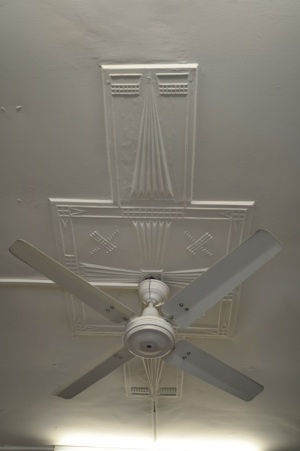
Internal chapel ceiling plaster detail. All this would be lost under the DA. Image Rappoport Pty Ltd.
‘GUNYAH’ STILL UNDER A THREATENING CLOUD

Having endured in recent times an allegedly corrupt mayor, excessive developer-biased rezoning and a rapid changing of the character of their suburbs, Sutherland Shire residents now face the very real prospect of losing their oldest building, thanks to an errant council who seem determined to dig up, sell off and knock down as much as they possibly can during their time in the sun…
Sutherland Shire Council seems intent on pushing through its draft LEP, which will not only raise the building densities of many of the beachside suburbs, but also seeks to remove its oldest house from the heritage list. The worker’s cottage, at 5 Evelyn Street North, known as ‘Gunyah’, dates from c.1870 and formed part of the vast Thomas Holt Sutherland Estate. It is in fact the only remaining physical link to the estate and widely recognised as the oldest house standing in the Shire.
All this hasn’t stopped council from seeking to de-list the building, claiming restoration costs as being prohibitive. But there are a few fishy smells coming from Sutherland Shire’s reckless decision making… remembering council actually owns the site, and has let the building slip into disrepair over a period of more than a decade through total lack of maintenance.
And also remembering that the entire draft LEP springs from the troubled tenure of former mayor Kent Johns, who resigned both his mayorship and pre-selection for the state seat of Miranda in disgrace after allegations of corruption following his famous last-minute Mayoral minute, these are all reasons for concern. He remains on council, and many of his Liberal colleagues are still running the show, such as Cr Kevin Schreiber.
And the fact that this decision contradicts advice from not only council staff, but also the State Government independent review panel means councillors intend acting without any given mandate, neither from the public, nor state government, nor even their own council officers. This simply defies logic.
By de-listing the house they stand to now make a massive profit by on-selling the land as a greenfield development site. Perhaps rezoning is on the cards, as has occurred directly across the road where townhouse-units are now being built. The property minus the cottage would be worth a pretty penny (reportedly up to $1.8 million), considering its proximity to the shoreline and desirability of location.
Cr Kevin Schreiber, a Liberal councilor who served as deputy mayor 2012-13 next to Johns, told Fairfax “As much as we like to keep our heritage sites, … the cost far outweighs the benefit to the community.” But we can take what he says with a little grain of salt. Schreiber himself was referred to ICAC for questionable development approvals and political donations back in 2008, along with three other Liberal councillors including our friend Kent Johns.
Schreiber and Johns denied the claims, which related to 30 non-compliant approvals within two years, but all the councillors were de-listed from the Liberal party at the time and forced to register as Indepedents. That makes three times since 2002 by my reckoning Kent Johns has been involved in ICAC referrals, and yet this character remains a B ward councillor in the Shire still making planning decisions. Is there any wonder the LEP has turned out like it has?

Two peas in a pod, councillors Johns and Schreiber, both part of the Liberal team, both with corruption allegations against their names. Image Fairfax Media.
Current deputy mayor Tom Croucher, another member of the Liberal dream team, claims the council can’t afford restoration. “The council has no funds to restore it. I ask it be removed from the heritage list,” he said. Simple as that…
Okay let’s assume that to be true. That they can’t afford it. It may well be… So what gives them the right to de-list the building as a heritage item? Just because they can’t afford to fix it? It makes no sense to me at all, am I missing something here? If you or I own a heritage-listed house, and we decide we can’t afford to renovate it, does it then get de-listed, and sold to the highest bidder as a development site? Is that how it works? I really don’t think so. I could be wrong, but I didn’t think it worked that way. If it did there wouldn’t be many heritage listed homes left.
The clear and logical solution for Sutherland Shire Council is, if they really can’t afford to renovate the cottage – this asset to the people of the area, this visual link to early European settlement – then don’t. Sell it as a heritage listed item for somebody else to renovate, or lease it as a museum for people to enjoy. Don’t destroy the very local heritage you are meant to protect just to turn a bigger land sale profit, that is not the right thing to do. It may sound clichéd but once it is gone, it is gone for good, there is no bringing it back. And buildings of this vintage, in this locale, with heritage links to our founding forefathers, are already few and far between.
I implore people, residents and non-residents alike, to contact Sutherland Council, and ask that they not go ahead with de-listing and demolishing this important cultural asset as it would be an irreversible loss to a community so closely tied with the early European settlement and growth of Australia.
Email Sutherland council ssc@ssc.nsw.gov.au
The safety fence has already gone up around the house, this is not a false alarm.
PETERSHAM ‘EYESORE’ IN THE WAY OF A PARKING LOT
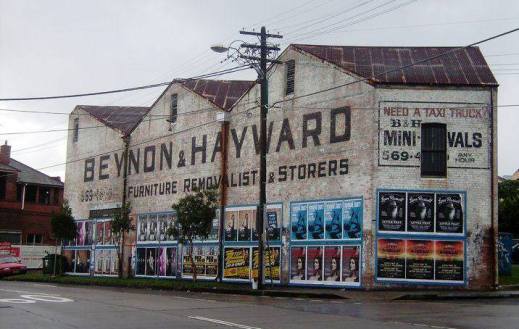
Occasionally one gets relegated to the sidelines in this age of heritage mayhem while family matters, other choirs, and real jobs get in the way. But then something happens – a misguided decision by an ignorant council or a just plain silly comment by some rogue councillor that lights a spark inside that makes you want to take up the charge again.
This time the council is Marrickville, and it relates to their decision to totally ignore the advice of their own heritage advisor’s report and not heritage-list the unique 1886 brick warehouse at 6 Livingstone Rd. Petersham owned by Beynon & Hayward furniture removalists and storers. The building was linked for many years to James E. Gould, a local produce merchant who served as Alderman and Mayor on Marrickville Council over a period of over 18 years, and was purpose-built to suit the narrow triangular site over two stages between 1886 and 1904.
Certainly the shape of the building is quite individual, and from some angles almost looks like something conceived by the mind of the great Dutch illusionistic artist M.C. Escher. That combined with the corrugated iron roof and a real ‘wild west’ silhouette has made the warehouse quite a landmark for locals and visitors passing by on their daily commute.
Already the council has been slammed by the Australian Institute of Architects and the National Trust for not considering the much loved warehouse important enough to place in protection of a listing. On the contrary, certain councillors are calling for it to be demolished in favour of units or a carpark. Independent councillor Victor Macri has notably referred to it as “an eyesore”, seemingly oblivious to the rare heritage qualities of the shape and form of the classic 19th century warehouse.
I think it is a wonderful building, and find Cr. Macri’s attitude extremely dangerous for a councillor in a renowned heritage area such as Marrickville to have. I don’t believe he reflects his ratepayers’ beliefs in any way, and if you are a resident within the Marrickville council area with any sort of knowledge and respect for Australian merchant heritage, perhaps you should think very carefully before giving people like this any semblance of power at the next local elections. Hopefully the building will still be standing by then.
Looking at an aerial view of the site, council’s intentions become clear. To expand the neighbouring council-owned carpark by simply eliminating the warehouse is just taking the easy option. The fact that Cr. Macri owns a hairdressing salon on Marrickville Rd. may tilt his opinion on the need for more local parking somewhat.
In any case the thought of replacing a heritage building such as this with a carpark is an outdated one. One similar example that comes to mind took place at Mortdale a couple of years ago when a local Masonic Hall was bulldozed to make way for an unnecessary carpark, and was widely deplored by residents all round.
The need for more carparks will be totally dependent in the future on the use or over-use of cars. The car as a mode of transport will one day become redundant as the road system fails to cope with the increase in traffic to the point where it simply breaks down to total gridlock altogether. Certainly in the current phase of government initiatives there is little contingency for this forecast situation except for building more carparks. Will that solve the problem of over-congestion, or will it simply encourage more of the same? Marrickville Council seems to think it is part of the solution, and aims to sacrifice important local heritage to achieve this short-sighted goal.
At least some voices of reason on council still seem to recognise the importance of putting heritage ahead of whimsical planning folly. Liberal councillor Mark Gardiner stated to Fairfax “It’s not for councillors to decide what buildings are important. It’s for councillors to take the advice of heritage experts and they are saying strongly that this building is important.”
Indeed it is important… As a general rule if an expert heritage report states an item is important, it probably is. That’s why it is written by an expert. And if a council is voting on the future of a heritage building, but that same council owns a carpark next door that it wishes to expand, that, to me is called a conflict of interest. Will this conflict of interest be the death of another iconic heritage building in Sydney’s suburbs? We all have the right to voice our concerns and condemn what we know is wrong.
Inheritance has written to Marrickville Council to formally object to their decision.
Main title image by Jo Catherine.
WAR MEMORIAL SYNAGOGUE ACKNOWLEDGED

This is another good news story – amazingly that makes our second for the year, I think I need a Valium. It relates to a former synagogue in Strathfield, and the local council’s unusual move to heritage-list the building against the wishes of its owners. This doesn’t happen every day, for some councils it doesn’t happen every year, and for many it doesn’t happen at all. So first and foremost our congratulations go to Strathfield Council, who passed the motion 4-1 at its 21 May meeting, and of course Mayor Daniel Bott who initiated the heritage listing.
Naturally for every good deed there is a denier, and in this case it is the New South Wales Jewish Board of Deputies, who represent the building and the land it sits upon, and have declared their intention to sell off the synagogue as a prime development site. This is despite Strathfield Synagogue vice-president Sam Steif telling the Australian Jewish News in 2011 that “the only way we are going to get a minyan is if we put a mirror on the wall, but we will not sell the synagogue… If we got to that point I would go to the Jewish Communal Appeal and the NSW Jewish Board of Deputies and do anything I could to save it because this is a war memorial synagogue and we need to keep it.”
Unfortunately for the Jewish Board’s plans for sale, the heritage listing has complicated matters somewhat.
Built in 1959, the synagogue, known as the War Memorial Synagogue due to its internal plaques adorning the walls that commemorate Jewish victims of the Holocaust, was closed in 2011 as a result of shrinking congregations. The multicultural area was once rich with postwar Jewish immigrants, but over the ensuing decades the demographic has obviously changed as many of the Jewish families have moved away.
A preschool that operates on the site was initially set up for Jewish children but now caters for the greater community, and despite the closure of the synagogue, the site still operates at a profit thanks to the ongoing preschool lease.
Samuel Tov-Lev was the resident Rabbi for 15 years but his contract has since been terminated and he was effectively locked out of the site. He has campaigned for the heritage listing of the synagogue against the Board’s aspirations, and gathered 12,000 signatures in support. He sees the heritage of the building as unique in the area and deserving of recognition and retention. When asked about the successful heritage listing by Australian Jewish News he replied “I’m pleased but at the same time I’m very sad to see people calling themselves Jews fighting to destroy the holy and sacred synagogue.”
The Jewish Board of Deputies sees it only as an unexceptional building that contains plaques that could readily be moved to the centralised Sydney Jewish Museum. They have even gone so far as to say the naming of the ‘War memorial Synagogue’ was purely for taxation reasons, as memorial items attracted tax concessions at the time.
What they fail to acknowledge is that the heritage of the site is more than just the plaques that can be lifted and replanted elsewhere. It is, as with all heritage listed items, the synergy of the whole… It is the presence of the plaques, within the community where it was created, it is the modernist building design that reflected a new life for many postwar Jewish immigrants, away from the trauma of war, to a new country, a new community, so welcoming and accepting of refugees and settlers from all corners of the globe, and the symbolism that represents. It is the growth of that community to form a new society in a land so far away from their roots. It is the freedom and acceptance that made Australia such a reliable refuge for peoples removed from their homelands. And the simple walls of this synagogue represent much of that sentiment.
I think, despite the Jewish Board’s opposition, that Jewish people in general would be grateful for the protection of this historic suburban synagogue. I think that residents of Strathfield would be grateful for their council’s bold actions. And I think Australians in general would be grateful for the preservation of a piece of multicultural heritage, a small contribution to a country so great that people traversed the globe en masse because they wanted to live here – and part of keeping that country great, an important part, is maintaining its heritage for future generations to see, not just internal fixtures but the physical structures – and that blinding truth, unfortunately for some, far outstrips the requirement to make real estate profits to the maximum level.
Link to Strathfield Council’s Heritage Review of the War Memorial Synagogue site here.
Main image courtesy Australian Jewish News.
Thanks to Quentin Dempster on ABC’s 7.30 New South Wales for publicizing the story.
THE CHANGING FACE OF FORSTER-TUNCURRY

Sydneysiders are familiar with the seaside holiday town of Forster on the NSW mid north coast. Many of us have spent summer vacations in and around the centre, with its abundant beaches, rivers and lakes offering plenty of outdoor activities for the visitor. As a result of this popularity the skyline of Forster (and its twin town Tuncurry to the north) has burst sharply skyward over the years, as open real estate around the town becomes scarcer and developers move in to take advantage of the area’s cashed up holiday rental crowds.
On my last visit, I found something I didn’t really expect – a formerly sleepy seaside hamlet on the verge of much bigger things. Already several big towers have sprung up creating more of a Gold Coast style resort, leaving in their shadows vast chasms of crumbling vestiges of bygone days; fibro beach shacks and modest brick freestanding cottages, all but now slowly disappearing under the growing weight of modern skyscrapers.
What amazes me is the speed at which Forster and towns like it are changing, and just how easy we are to throw away any pieces of our past like scraps of bone to a hungry dog. Every corner you turn in Forster you see For Sale signs propping up decrepit buildings, or safety barriers around abandoned houses and 60s era motels, as they are no longer seen as profitable and either left to rot or handed over to caretaker real estate agents to find suitable developer buyers who have no qualms about turning these little slices of history into contemporary piles of rubble, with their high volume high density money making concrete cubes rising from the ashes…
So who will miss these vestiges, these quaint beach style fibro and brick cottages with their dried up gardens of hibiscus and frangipani that have served their purpose well over the years but just don’t make the cut anymore in this profit orientated, market driven, real estate focused society we call Australia?… I for one. I see the beauty in these buildings, these modest, airy, charming, homely remnants of a disappearing world that have been unashamedly sold out exclusively for the real estate value of the dirt on which they sit.
I believe the council and state government should be looking at the heritage value of certain examples of this style of Australian coastal architecture, c.1920s – 1960s and preserving them rather than allowing wholesale destruction, and at the same time applying the brakes to the total redevelopment of coastal towns like Forster, which is occurring more rapidly than many would like.
‘Tikki Village’, pictured below, is one example of a land sale that recently occurred for over a million dollars, presently holding several ornate little fibro cabins that serve the community with cheap long term rental options, but zoned for medium density development and at risk of being turned into towers.
If you want to see the real Forster, the old Forster as it was, you’d better go soon as much of it is rapidly changing. Locals are quick to point out how the character of the place is briskly disappearing, never to return as it was. Below is a gallery of photos of the town, including ‘Tikki Village’, but be warned, many of the buildings shown won’t be there for very much longer, or may in fact already be gone.
All photos copyright Inheritance.
THREE GENERATIONS OF BAY ST. FELLED FOR UNITS

Three generations of architecture sitting side by side are to make way for units along Rockdale’s busy Bay Street leading down to historic Botany Bay. A simple 1800s workers’ cottage, a free standing Victorian villa complete with original slate roof, and a brown brick Federation have been vacated and await demolition surrounded by a fence of doom, in an area that has the highest expansion rate for unit building currently in the state. A DA to turn the site into 19 strata units was lodged in December 2013 by applicants J & M Faddoul Pty Ltd, at a building cost of $3,275,000.
Rockdale Council seems to find no heritage value in these items that have stood for more than a hundred years and overlooked the constant march of progress stemming up from Botany Bay and down from the town centres where Thomas Saywell’s famous steam tram once traversed. Instead more and more units have now become the order of the day. Even a now rare workers’ cottage can’t stand in the way, nor a stunning double storey Victorian villa with many ornate original features, reminiscent of the recently lost Griffith House on the grounds of nearby St George hospital.
It seems an unnecessary shame that buildings like this are allowed to be felled continuously in this so-called enlightened age, in fact the rate of heritage loss seems to be increasing as large swathes of Sydney are rezoned for unit development, a trend which will no doubt spell the end for many similar buildings especially in areas such as Rockdale, where councils simply don’t have a clue as to their duty of guardianship, choosing rather to tow the Liberal state government line of urban renewal at all costs.
Rockdale Council is currently assessing another potential overdevelopment on the nearby Darrell Lea site on Rocky Point Road. The chocolate factory is to make way for between 350 and 600 dwellings, rising over the 3.3 hectare site in towers up to 12 stories high, within a LEP that currently allows four. In order to accommodate this scale of development, the land would have to be rezoned to R4 high density residential, a move which Rockdale Fifth Ward Ratepayers Association disagrees with, citing privacy, traffic congestion, and lack of amenities (there is no rail station nearby). However Rockdale Council has already adopted a motion to support the planning proposal, meaning residents may just be left as innocent bystanders in the process. Long live democracy in Australia… At least the developers have theirs.
All images by Inheritance. Click on gallery below for slide show.
THE FATE OF FATIMA ISLAND
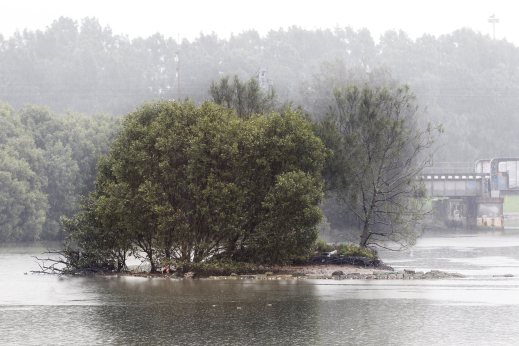
We begin the year on an island. Which is not an unusual circumstance for a heritage advocate… But don’t let me lead you to believe this is another negative news story. No, we are starting on a positive note for a change (hopefully)!
Fatima Island, on a bend in the Cooks River at Tempe, is a small vegetated mudflat that has been disintegrating by the year. Now it has come to the attention of the Cooks River Valley Association who have duly raised awareness with Marrickville Council.
The island will be immediately recognisable to the many commuters who travel by train into the city every day along the Illawarra Line. As the city bound train crosses the bridge at Tempe the island comes into view from the east – I can clearly remember over my years of commuting to the city, looking out and seeing the little island sitting there, often populated by waterbirds oblivious to the rapid urban development encroaching all around… Fatima Island, and closer to Central, Sharpie’s Golf House sign, the first electrified advertising sign in Sydney, taken down in a blatant act of heritage vandalism several years ago – these were the two landmarks that stand out in the memory of my daily commute whilst peering out of the train window.
Although Sharpie’s Golf sign is long gone, sadly never to reappear, Fatima Island is still clinging on to the riverbed in its isolated vulnerable form. It is in fact the last remaining of a series of natural sand bars, and provides vital pest-free habitat for waterbird species including pelicans, ibises, cormorants and seagulls.
The island’s sandstone retaining walls, made of reclaimed convict hewn blocks, were built in 1901 as part of a public works program, but the naming of the island came about 50 years later. Remembering a monastery stood just across the river near Tempe House, The name ‘Fatima’ has it beginnings in a local Catholic Rosary pilgrimage in 1951 on the banks of the Cooks River to honour Our Lady of Fatima, channeling the Portuguese icon of the same name. At the time, Pope Pius XII asked Catholics across the globe to pray to the Virgin Mary ‘with greater fervour of the heart as is demanded by the increasing urgency of the need as well as the conversion of Russia back from communism.’
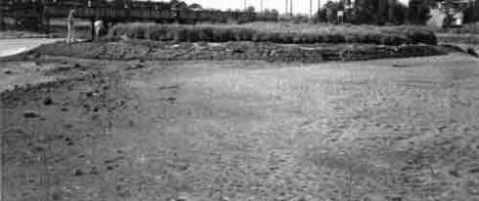
Fatima Island in 1984. Photo by Chrys Meader. Source Marrickville Heritage Society & Cooks River Valley Association.
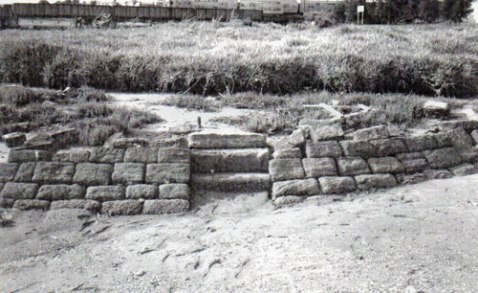
Fatima Island in 1984. reclaimed convict stone retaining bank present. Photo by Chrys Meader. Source Marrickville Heritage Society & Cooks River Valley Association.
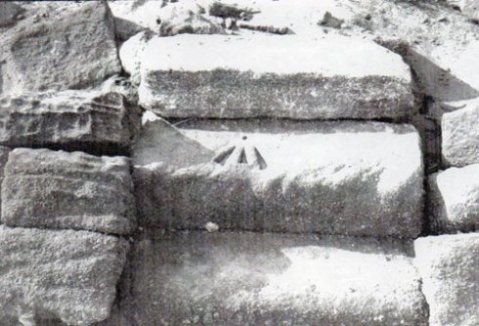
Fatima Island in 1984. Note convict markings in steps. Photo by Chrys Meader. Source Marrickville Heritage Society & Cooks River Valley Association.
The wall has recently all but washed away due to factors such as boat wash, human visitation, de-stabilisation and natural erosion. The island is now only a fragment of what it once was, trees have fallen over and top soil been stripped away, and the next phase would be its complete loss in time.
Marrickville Council seems to be listening to concerns of local groups including Inheritance. In response to our submission and at a recent council meeting the feedback has been positive, and it now seems that Marrickville Council will be allocating $25,000 for a remediation works study on Fatima Island. This will go some way to restore what is esentially a significant bird habitat, a known piece of local heritage and a quirky piece of nostalgic landform with links not only to the Catholic Church, but the local Portuguese community and 1950s cold war!
Something as unique as this is surely worth protecting. And it is indeed heartening to see a council actually acting on behalf of a community for a change.
Main image John Veage, the Leader.
NAVY FLEET REVIEW: AN OPPORTUNITY MISSED?

I like many other proud Australians ventured into Sydney Harbour over the October long weekend to take a look at the marvellous celebrations based around the Royal Australian Navy’s centenary and Fleet Review. It was 100 years to the day on 4th October, when 7 ships of the original fleet of the newly formed Royal Australian Navy sailed through the heads and into Sydney Harbour. Now, tremendous festivities were held to mark this great occasion, including a re-enactment of the entry by modern warships of the RAN and a flotilla of international ships representing 17 nations, a parade of 16 historic tall ships from around the world, RAAF fly-overs, fireworks and light show spectacular and of course the visit of His Royal Majesty Prince Harry to review the fleet.
Considering the enormity of the occasion, marking 100 years of continuous service of the Royal Australian Navy, through two World Wars, Korea, the Cold War and more, with all the tradition this entails, I can’t help reflecting what a shame it seems now that the Hammerhead Crane at Garden Island, a perfect backdrop to the passing parade of warships, will be sacrificed by the Federal Government for the sake of saving a relatively small amount in maintenance costs.
When you look at the costs involved in putting on this Fleet Review, a whole lot of pomp and ceremony that lasts only a few days – and enormous costs they are, 40 million dollars to taxpayers including a 10 million budget to keep the ships tied up and open, it seems so deceptively wrong that the Australian Defence Force has cried poor this whole time not being able to find the relatively modest funding of $700,000 in maintenance required to upkeep the Hammerhead Crane. This after all, would be the ultimate lasting tribute to the heritage of the Navy in its 100th year – a full restoration of a Sydney icon and renowned symbol of the Royal Australian Navy… A distinctive feature of the Garden Island base and the Sydney Harbour skyline, a truly extraordinary piece of Naval engineering and an asset to the people of Sydney.
To spend just a fraction of what was outlaid for a ten minute fireworks display would have truly left a far more lingering impression in highlighting the longstanding heritage of the Navy in Australia and in Sydney Harbour. While the fireworks quickly went up in smoke like every other generic New Year’s display, the preservation and restoration of the famous crane would have been timeless and benefited Australians for far longer than just ten minutes.
Of course I am not anti-celebration… Just let’s make heritage part of the celebration… It is a celebration of Naval heritage after all…
I guess it may be just too much to ask, perhaps a little too illogical in today’s throw-away society, that a living piece of naval architecture be preserved for posterity as opposed to watching 3.9 million dollars worth of lights and gunpowder smoke go up into thin air.
Still, when future generations look back at 2013, the centennial year of service of our great Royal Australian Navy, and they see that the defence budget allowed for 40 million dollars of tax payers’ money allocated to a single weekend spectacular, while $700,000 couldn’t be found for the long term preservation of a heritage icon, they may just be scratching their heads and wondering if the spectacular Navy Fleet Review was little more than just an opportunity lost.
All images below Inheritance. Click on one for slideshow (not the 40 million dollar kind)… Title image of fireworks courtesy ABC.
‘THE SHIRE’: A TALE OF THREE JETTIES

There’s something almost surreal about standing and looking over an object that fits into its environment perfectly, that enhances its surroundings simply by being there, that seems like it has been there forever, but is set to disappear from view, for the whimsical short term gains of a clearly ignorant and questionably shady council.
Three jetties in the Shire (one at Gunnamatta Road, Cronulla, as well as the Scylla Bay Boat Ramp and Wharf, Como, and Burraneer Jetty at Lugano Avenue, Burraneer) have been earmarked for removal by the pathetic Sutherland Shire Council due to maintenance costs the council is simply not willing to wear. This is the same Liberal dominated council headed by (until recently) Mayor Kent Johns who is reportedly under investigation for accepting political donations for his Federal Campaign from property developers in exchange for reciprocal favours, at the same time rezoning large tracts of the Sutherland Shire to allow massive and unprecedented high rise developments, getting rid of the ombudsman who oversees corruption and even going so far as to protect developers from legal action against any wrongdoings. See the details here.

The questionable ex-Mayor Kent Johns. With power brokers like these at the helm of council, heritage is in trouble. Image John Veage.
For the locals of these areas, the jetties represent something more than just a form of aesthetic beauty. There is a function performed, a duty as it were, to the people of the Shire. Somewhere boats can tie up, kayaks can launch, a lazy line can be cast, and a sunny afternoon squandered happily away. There is nothing quite like sitting on the edge of a rickety jetty, dangling your feet over the edge, and mulling over a quandary or two while admiring the view of the world listening to softly lapping waters. Australia is a country designed for these jetties, and their loss makes us all a little poorer. Certainly our bays and hamlets would seem rather naked without them.
Heritage they are of course. Standing for many years and serving their purpose with quiet esteem, requiring very little to maintain in return, and beautifying the outlook like nothing else can. The Burraneer jetty stands watching the return trip several times every day of the 74 year old M.V. Curranulla, the Cronulla-Bundeena ferry, the oldest commuter ferry in fact in Australia working to a regular timetable. The jetty returns the favour, giving the passengers something to look at too, adding unquestionably to the maritime heritage of the bay and the Port Hacking River.
It appears as though this particular jetty suffers from sag due to insufficient and rotting piles holding its weight. A few more piles added and a bit of straightening would solve this problem, a far better alternative than the destruction of the wharf.
The other, at Gunnamatta Road, Cronulla (over 100 years old and formerly known as the ‘Hospital Bay Wharf’ built for taking quarantine cases from coastal vessels) doesn’t appear to have condemning maintenance issues at all. This one has received the most public attention, and may have garnered enough support to be saved yet, attracting a petition of 850 signatures in only 14 days, despite the council ignorantly rejecting and insisting the submissions be lodged electronically.
A third jetty, the Scylla Bay Boat Ramp and Wharf, at Verona Range, Como, is also proposed to go, but this one would at least be replaced under council plans.
At the time I investigated the Burraneer Jetty, it was a beautiful day, the sun was shining through an azure blue sky onto glowing waters. The Bundeena ferry chugged closely by as it had for many decades. I admired the reflections from crowded rock pools and sandy shallows up to the splintered hardwood timbers of a timeless whitewashed jetty.
While over at Gunnamatta Road, the view from the hill above was sublime. Stepping down the 1912-built steps carved out of sandstone onto the wooden landing is like stepping closer into a scene from paradise. Postcard-perfect, soaked in sunlight and there for us all, free of charge. A beautiful piece of man-made infrastructure that enhances its surrounds immeasurably while allowing the user to actually immerse himself and become part of the scene – such a rarity in any form.
A local was nearby, an old-timer looking over the scene. “Are you a local?” I asked.
“Since 1939” was the reply. But he seemed oblivious to the imminent loss of the wharf…
“That’s the wharf they want to get rid off” I commented.
“I hope not… This place is magnificent” was the reply.
If only he knew.
All images below by Inheritance 2013. Click on one for slideshow.
SMH story: Sutherland Council favours those with Liberal connections
SMH story: Rainbow Connections
SMH story: Cloud over ex-minister’s campaign donations
SMH story: September 21, 2013
SMH story: September 22, 2013
SMH story: September 26, 2013
SMH story: October 2, 2013
